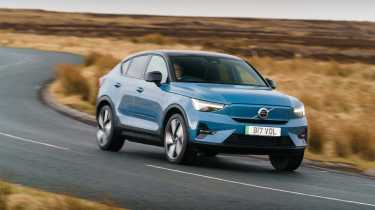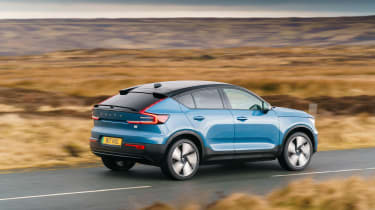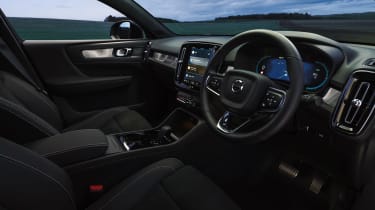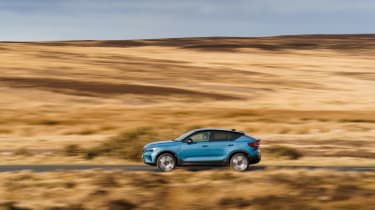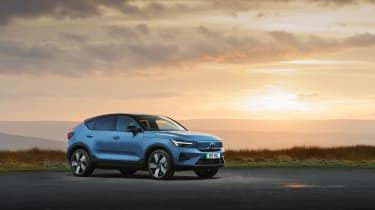Volvo C40 Recharge Twin 2022 review – a serious go at the status quo
It’s compromised in many senses, but Volvo’s C40 is the best Volvo in ages – we mean it!
Electric, coupe-slash-off-roader crossover, Volvo. We’re not off to a great start, are we? But before you click back on your browser, let me be upfront and say that this is the best Volvo we’ve driven in a very long time, and not just because it’s chuffing quick in a straight line. Let me explain.
The C40 Recharge’s development path is pretty easy to understand. It’s based on Volvo’s compact SUV, the XC40, which started life as a pure-combustion model, but has slowly been picking up evermore electrified variants over the years, leading up to an all-electric model called the Recharge – on which this C40 is based. Both models also share their chassis, battery and electric motors with the Polestar 2, which means rather than a typical ‘skateboard’ platform as you’ll find on rivals such as the Audi Q4 e-tron, the C40 has an adapted chassis, with batteries placed in modules throughout the body.
The C40 is available with a single motor option, but the car we’re driving here is the Recharge Twin dual-motor variant, the same, incidentally, as the fastest Polestar 2. It produces 402bhp and 487lb ft of torque, and will get to 62mph in 4.7sec despite weighing an astounding 2110kg. This doesn’t make it the most powerful or accelerative Volvo on sale right now – that goes to the rapid and largely flawed S60 T8 saloon – but due to its fuss-free drivetrain makes much better use of its available power.
To look at, it’s very clear that the C40 is derived from the more upright XC40. Most of its bodywork below the beltline is shared, but it’s the roof which is new. It’s hardly a groundbreaking move, but in Volvo’s defence it’s certainly not the worst application of a sloping roofline on an SUV, and in combination with some slick new LED lighting, a glass roof insert and new 20-inch wheels, makes for a clean, if not exactly elegant design.
More reviews
Group tests
- Alpine A290 v Alpine A110 – how much DNA do they really share?
- Ariel Atom 4R v Caterham Seven ‘evo25’: power-to-weight heroes go head-to-head
- Caterham Super Seven 600 v Super Seven 2000
- Levante v T1
- Corvette Stingray v Porsche Cayman GTS v Audi R8 RWD
- Great Ferrari hypercars driven: 288 GTO, F40, F50 and Enzo head-to-head
- Hardcore Ferrari V8 specials go head-to-head
- Lamborghini Aventador Ultimae v Lamborghini Countach
- Lotus Emira v Morgan Plus Four – four-cylinder Brits go head-to-head
- Toyota GR86 v BBR Mazda MX-5: supercharged drop-top battles sports coupe
In-depth reviews
- Abarth 600e 2025 review – Italy gives the Alpine A290 something to worry about
- Alpine A110 review – distinctive, lightweight and unforgettable to drive
- Audi R8 (2015 - 2024) review – the ultimate soft-focus supercar
- Bentley Continental R Mulliner: review, history and specs
- BMW 5-series review – is this still Munich’s anchor model?
- BMW 1-series review – Munich’s Audi A3 rival gains focus
Long term tests
- Abarth 695C Turismo Fast Fleet test – 10,000 miles in the Italian hot hatch
- Alfa Romeo Giulia Veloce Fast Fleet test – 7000 miles in the sharp Italian saloon
- Alpina B10: end of term report
- Alpina B10
- Ford Mustang GT
- Ford Mustang GT
- Ford Mustang GT
- Land Rover Defender 110 Fast Fleet test – 9000 miles in the go-anywhere SUV
- Maserati Ghibli Trofeo Fast Fleet test – 4000 miles in the Ferrari-powered saloon
- Mitsubishi Evo MR 340
Review
- New Aston Martin DBS 770 Ultimate review – 759bhp super-GT driven
- New Bentley Batur 2023 review – can it possibly be worth £1.65m?
- 2023 Chevrolet Corvette C8 Z06 review – the American 911 GT3?
- Kia EV6 GT-Line S prototype review – the EV that shows how it’s done
- BBR Supercharged Mazda MX-5 (ND) 2023 review – tuned 250bhp roadster driven
- MG4 Trophy 2023 review
Reviews
- Abarth 695 75 Anniversario edition 2024 review – a fitting send-off for Abarth’s hot supermini?
- Abarth 500e 2023 review
- AC Cobra 378 Superblower MkIV 2021 review – another V8 Cobra, but with a GM heart this time
- Acura Integra Type S 2024 review – a Honda Civic Type R with added restraint
- Alfa Romeo Giulia 2025 review – get one while you still can
- Alfa Romeo SZ: history, review and specs of an icon
- Alfa Romeo 1750 TBi
- Alpina B3 GT Touring 2025 review – a 190mph alternative to the BMW M3 Touring
Step up into the slightly too-familiar cabin and you’ll notice that all of the digital interfaces are in fact new and far more resolved. Part of that credit can go to Google, as it partnered with Volvo in the design and layouts of this new generation. This doesn’t erode Volvo’s typical traits such as build quality, refinement and general sturdiness, either, so overall makes for a good experience.
Yet much of our reservations about modern Volvos refers to two main factors: their lacklustre powertrains and leaden chassis set-up. First of all, considering the 20-inch wheels, the ride is firm, but actually well damped and controlled (large wheels negatively affect Volvos more than other manufacturers, it generally seems). Some of this has to do with the lower(-ish) centre of gravity granted by the C40’s electric powertrain, but that horrible brittleness that often applies to Volvos fitted with a bigger wheel option is well taken care of. In symbiosis with the chassis is the steering, which despite being completely synthetic in feel, is much more responsive and accurate than the over-light and sometimes vague set-ups found in other Volvos. It feels far more Polestar than Volvo.
The powertrain is typically EV-smooth, but work on the throttle and braking calibrations has worked wonders – the C40 feels far more natural and responsive to drive than any combustion-powered Volvo of this generation. Start to dip into the C40’s reserves of performance and the chassis doesn’t begin to wilt, either. Instead, the body will load the suspension, and shoot the car forward with surprising levels of composure. It doesn’t have the agility of Porsche’s Macan, but it certainly drives better than Audi’s Q4 e-tron and even Hyundai’s Ioniq 5.
But, and there was a but coming, the compromise in the C40’s case is range, or the relative lack of it. Dual-motor versions have an estimated range of around 215 miles, which isn’t a lot considering the relative size of its 78kWh battery pack. Those aforementioned rivals go further on a charge, and largely because of their more efficient use of energy going and coming out of the batteries, rather than the amount being stuffed inside.
There’s a variety of factors that account for this, namely the massive kerb weight and slightly outrageous performance, but it’s also clear that the wide, performance-oriented Pirelli P Zero rubber that helps make the C40 so capable to drive, is one more contributing factor.
A fresh, and frankly critical, figure Volvo decides to publish alongside the price is a rudimentary life-cycle analysis of its C40 Recharge models. These figures don’t just take into account its manufacturing and logistics, factoring in suppliers, but also the use phase over a 200,000km period. Volvo quotes that when charged on a global energy mix, a C40 Recharge emits a lifetime CO2 figure of 50 tons, 53 per cent of which is made up by its manufacturing, and 47 per cent its use phase. Charge with green electricity and this figure plummets to 27 tons, with 99 per cent of its footprint made up by its manufacturing phase.
These numbers are meaningless without context, so Volvo’s included a petrol-powered XC40 for comparison, which emits a total CO2 figure of 59 tons, 27 per cent of which is derived from manufacturing, with the remaining 73 per cent coming from the fuel it burns over that 200,000km period. Convert its fuel use to carbon-neutral eFuels, and its much smaller manufacturing footprint swings the overall figure back in the opposite direction. These figures have no external and independent verification like WLTP MPG or CO2 figures, but it is at least a positive step towards Volvo acknowledging the importance of transparency about its carbon footprint, especially considering the goal is to reduce emissions, not just displace them.
So take the Volvo on face value as a well-built, attractive and perfectly capable SUV that’s also surprisingly rapid, and there’s plenty to like – against its combustion-powered alternative, it’s the better car. But look at the bigger picture and you’ll note there’s still some ways to go, not just for Volvo, but for all manufacturers diving into electrification without checking the pool depth first.
Prices and rivals
Like Polestar, Tesla and a growing number of other manufacturers, the C40 is not able to be purchased within Volvo dealers, and instead has to be ordered online. Prices start at £47,100 for the entry-level single-motor model, but will rise to £53,100 and £56,700 for the two higher trim levels with the same powertrain. Dual-motor models are curiously absent from Volvo’s pricing structure for now, but there was a price increase of around £3000 for dual-motor versions when both were available.
As for its rivals, there are plenty of circa-£50k electric crossovers available, none of which are particularly outstanding. Audi’s Q4 e-tron is sodden to drive, has a cheap interior and feels underdeveloped. Same could be said of the high-spec Volkswagen ID.4 GTX. Ford’s Mustang Mach-e drives better than the VW group stuff, but is more expensive than the Volvo, especially in GT form. Kia’s EV6 and Hyundai’s Ioniq 5 are the two most impressive EVs of this size, and while the C40 is nicer to drive than the Ioniq 5, the Kia is still superior. In fact, the Kia’s the superior EV in all aspects, and for now still rules the roost of this very popular bit of the EV market.

